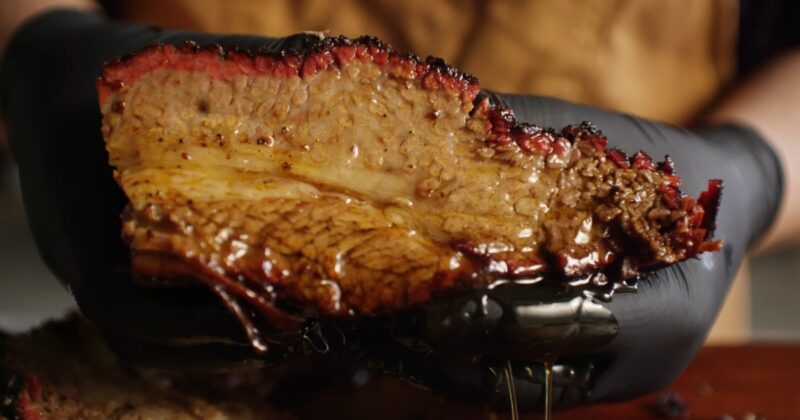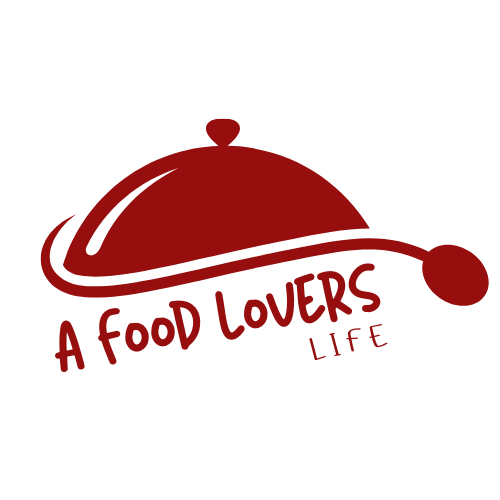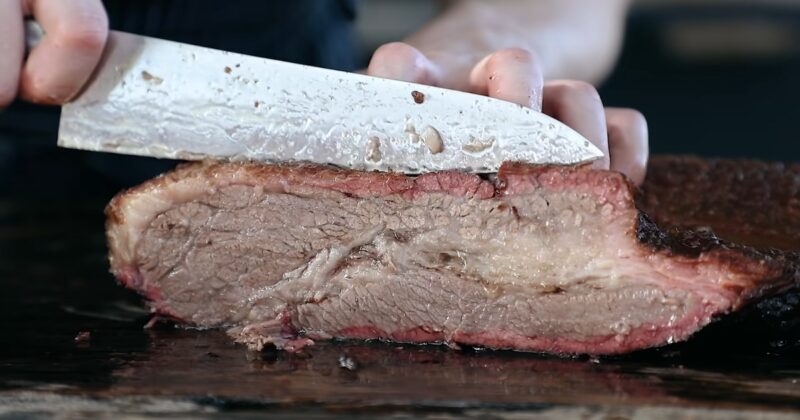A well-cooked brisket can be irreplaceable for any chef who appreciates quality meat. Now, I know you’re itching to find out the secret to that perfect smoke ring and melt-in-your-mouth texture, and trust me, I’ve got some juicy details to share.
So, how long do you smoke a brisket per pound? Well, it’s not just about time but also about patience. Generally, you’re looking at about 1 to 1.5 hours per pound at around 225°F. But don’t rush off just yet! Stick around, as I’ll further explain this process, and throw in tips on temperature control, wood choice, and that all-important rest time. There is a lot to cover, so let’s begin!
Choice of Wood
The choice of wood significantly influences the flavor profile of your smoked brisket. The trick is to find a balance that complements the meat rather than overpowering it.
Hickory
With a strong, bacon-like flavor, hickory is a favorite of mine. It pairs well with beef and is a fantastic choice for brisket.
Oak
Oak is a more moderate choice, as it offers a medium smoky flavor that doesn’t overshadow the brisket’s natural taste. It’s quite versatile and can be used throughout the smoking process.
Why Is Marination So Important?

It can elevate the flavors of your brisket and give it that special and unique taste you want. Aside from its rich flavor, marinating also helps tenderize the meat further.
Wet Marinade
I typically use a mix of liquid ingredients like vinegar, beer, or fruit juices for wet marinades. This not only gives a nice flavor to the meat but also adds more moisture, which always helps in the smoking process.
Dry Rub
I take a blend of spices and herbs, crafting a dry rub that I massage onto the brisket. I leave it to sit, letting the flavors seep deep into the meat. As it smokes, a crusty exterior forms, and enhances the texture of the brisket.
Time and Temperature

Two essential factors in the smoking process are time and temperature. These can be the difference between a juicy, flavorful brisket and a dry, tough one. It is something I learned through making mistakes, so you don’t have to.
The Ideal Temperature
I always pay very close attention to temperature maintenance. This is crucial, as it ensures that the brisket is cooked evenly without drying out.
- Smoking Temperature: The optimal range is between 225°F to 250°F. This low-and-slow approach lets the brisket cook thoroughly while remaining juicy.
- Internal Meat Temperature: Aim for an internal temperature of around 195°F to 205°F. This will break down collagen sufficiently, which results in more tenderness.
Time Taken Per Pound
While weight can guide you, factors like meat thickness and the smoker’s efficiency can also affect the actual cooking time.
- General Guideline: On average, you can expect to smoke your brisket for about 1 to 1.5 hours per pound. So, a 10-pound brisket can take anywhere from 10 to 15 hours.
- Factors Affecting Time: Factors such as wind, outdoor temperature, and the smoker’s insulation can directly impact cooking time. I always use a meat thermometer to ensure I’m as accurate as possible.
Tips for a Perfect Brisket

Even skilled professionals could face challenges sometimes. Here are some pro tips I’ve prepared that you will certainly find useful.
Maintain Moisture
A dry brisket is every pitmaster’s nightmare. Keep that meat moist to keep all the flavors and juices intact.
- Water Pan: Place a pan filled with water inside the smoker. As it evaporates, it keeps the environment moist, preventing the brisket from drying out.
- Misting: Some pitmasters swear by misting the brisket with apple juice or broth. I found that this is quite effective, but it also adds a bonus of enhancing your brisket’s flavor, so it’s a win-win situation.
Don’t Over-Smoke!
While we want a smoky flavor, there’s a fine line between just right and too much.
- White Smoke vs. Black Smoke: Aim for thin, blueish-white smoke. Thick, black smoke can make the meat taste bitter.
- Refresh the Wood: This is what I always recommend to beginners. Don’t overstuff your smoker with wood! Refresh as needed so that you can maintain consistent smoke levels and avoid over-smoking.
Rest and Slice
One of the most overlooked steps in the smoking process is resting. It is an absolute must, and you also need to do it right:
- Resting Time: Allow your brisket to rest for at least an hour after removing it from the smoker. This lets the juices redistribute, which means a delicious, moist bite.
- Slicing: Always slice against the grain. This breaks down the meat fibers, making the brisket more tender.
Equipment Matters

Make sure you have the right tools and to fully understand them, as it’s vital to get that perfect smoke.
Types of Smokers
There are so many smokers available, each with its unique characteristics.
- Offset Smoker: This one has a firebox attached to the side and is my absolute favorite. It grants me good heat control but requires frequent attention to maintain temperature. I always pay close attention to temperature, so it’s not an issue.
- Electric Smoker: With automatic temperature controls, electric smokers are the obvious user-friendly option. While convenient, I would argue they don’t deliver the same authentic smoky flavor. It’s just my personal opinion, and if this type suits you, go ahead and try it.
Accessories You Should Look For
Having the right accessories can make your smoking process smoother and more precise.
- Thermometers: Use a reliable meat thermometer to eliminate any guesswork. A dual-probe thermometer is my choice, as it can monitor both the smoker’s temperature and the meat’s internal temperature. Pretty neat combo.
- Heat Resistant Gloves: Handling hot grates and meat can be a challenge. I always use a pair of heat-resistant gloves for safety and convenience.
Potential Issues and Their Solutions

It is very useful to know some of these potential problems so that you can respond and resolve issues accordingly. Here are some issues I often encountered and managed to resolve easily:
Stalling Temperature
A common concern is the brisket’s internal temperature stalling during cooking, often around the 150°F mark.
- Why This Could Happen: This phenomenon, often referred to as “the stall,” is due to evaporative cooling. As moisture from the brisket evaporates, it cools the meat, causing a plateau in temperature.
- The Solution: I resolve this by wrapping the brisket in aluminum foil or butcher paper, which can help push through the stall. This method, also known as the “Texas Crutch,” reduces evaporative cooling, allowing the temperature to rise.
Dry End Results
Nothing is more demoralizing than putting hours into smoking a brisket only to find it dry.
- Potential Causes: Overcooking, cooking at too high a temperature, or not maintaining enough moisture in the smoker can result in a dry brisket.
- Solutions: I prevent this problem by monitoring temperatures closely and maintaining moisture in the smoker. You should also consider wrapping the brisket partway through the smoking process to preserve juiciness.
My Recipe
It may seem like a simple process, but many details can make a difference. In that matter, you will need some skills and experience to add a final note that will make this meat perfect according to your taste. Here’s my recipe with some tiny details you should pay attention to:
| Category | Details |
|---|---|
| Meat Selection | Full-packer brisket with good fat marbling. |
| Preparation | Trim fat cap to 1/4 inch. |
| Rub Ingredients | Equal parts salt & pepper (Texas style). |
| Wood Selection | Oak or hickory. |
| Smoking Temperature | 225°F to 250°F (107°C to 121°C). |
| Cooking Time | 1 to 1.5 hours per pound. Aim for internal temp of 195°F to 203°F (90°C to 95°C). |
| Resting Time | At least 1 hour in a cooler or turned-off oven. |
| Slicing Direction | Against the grain. |
Summary
The bottom line is there’s no one-size-fits-all answer to how long to smoke a brisket per pound. But if I had to give you a rule of thumb, I’d say you’re looking at about 1 to 1.5 hours for each pound of that beautiful cut of beef.
Just remember, it’s all about that low and slow approach, keeping the temperature steady and letting the smoke work its magic. The key is patience; let that brisket take its sweet time until it’s tender enough to melt in your mouth. It’s worth the wait.
I’m Jamie. On my blog, you’ll find BBQ recipes and cooking tips to help you make great food at home. Stick around for simple steps and secret ingredients that will help you enjoy grilling delicious food all the time.

